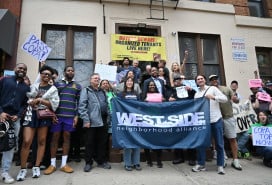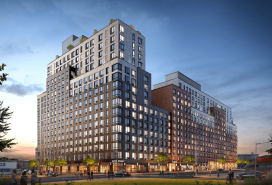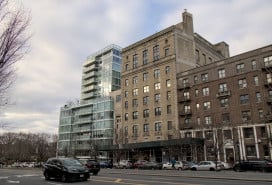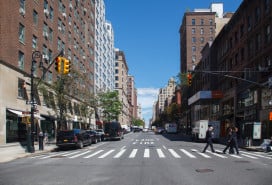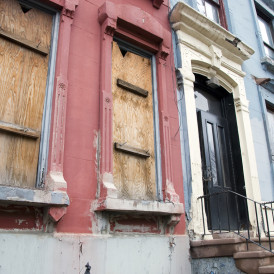The 10 Best NYC Neighborhoods for Families

Choosing the right New York City neighborhood is an individual endeavor for anyone, let alone anyone with a family. Add a kid or three to the mix and it gets exponentially more difficult. For one thing, real estate brokers are barred by federal discrimination laws from steering clients with children to areas that might fit best. (Even describing an apartment as “family-friendly” is verboten.)
For another, as more public and private schools open up, including in the outer boroughs, parents don’t necessarily pick where to live based on school choice alone. “Now when I have parents tell me what neighborhood they’d like to live in, I can generally give them three or four decent public schools in those neighborhoods,” says school consultant Robin Aronow, founder of School Search NYC.

Finally, with prices ticking upwards across the boroughs, buying or renting in the go-to kid-friendly neighborhoods may be wildly out of budget. “People should look at places in Queens and Brooklyn that aren’t immediately transparent and obvious, but because of, say, green space or close proximity to public transit, would lead them to believe that over time this is going to accrue value," says Michael Graves, a broker with Douglas Elliman.

With that in mind, BrickUnderground spoke to parents, real estate brokers and school experts, and sourced data on prices, listings, schools, crime and more to rank the 10 best neighborhoods for young families. (You’ll find an explanation of our methodology at the end.) The first half of this list is made up of under-the-radar ‘hoods that are (nearly) perfect for raising children, while the second half rounds up some of the classic spots to raise a family.
UNDER-THE-RADAR
DITMAS PARK

pat guitar via Ditmas Park Corner
Percentage of families: 33.55 percent
Median rent / sale price: $2,575 / $1.55 million
Homes on market: 19 for rent / 15 for sale
Number of schools: 23 (in Flatbush)
Number of trees: 3,576
Crimes per capita: 16.8
If you’ve heard of Ditmas Park—and outside of Brooklyn, it’s entirely possible you haven’t—then you’re probably picturing gargantuan Victorian houses with price tags to match. But think again: farther away from the Q train station (the neighborhood’s primary transit option, along with a couple of bus lines), pre-war co-op buildings provide a relatively affordable way to house a family.
Along with being one of the most diverse pockets of the city, it’s also known for its sycamore-lined sidestreets, while the main thoroughfare, Cortelyou Road, has sidewalks wide enough to accommodate several stroller-pushers walking shoulder to shoulder. Ditmas Park also has family-friendly businesses, like the Flatbush Food Co-Op, a popular (but pricey) natural grocery store, and several places that offer dance classes, crafts programs and even kids’ yoga. Indeed, even some of the bars—like Sycamore and Bar Chord—that attract a young crowd at night will find their backyard patios crawling with tykes on weekend days. Plus, the local school, P.S. 139 on Rugby Road, is an InsideSchools.org pick.
And, of course, if you CAN afford that Victorian, chances are you’ll get the kind of wide front porch, lush front lawn and spacious layout that will rival anything you’d find in suburbia.
FOREST HILLS

Percentage of families: 23.11 percent
Median rent / sale price: $3,600 / N/A (no three-plus bedrooms sold in July, but median asking price for August was $1.11 million)
Homes on market: 33 for rent / 40 for sale
Number of schools: 12
Number of trees: 1,155
Crimes per capita: 11.5
Dotted with Tudor and Georgian houses, as well as some co-op and rental buildings, Forest Hills has long been popular with families seeking a suburban experience within spitting distance of Midtown. It's not exactly a budget area, but compared to much of Manhattan and Brooklyn, prices for three-plus-bedroom homes are reasonable, and more available than in other parts of Queens. In fact, 73 of these larger places were on the market in August, representing the third highest number of properties for sale and second highest number up for rent in the borough.
Triplemint's Off-Market Advantage
Looking for the perfect home, but haven't seen one yet? Discover off-market properties in your dream neighborhood that suit your needs and budget. Meet and deal with sellers before their apartment or brownstone hits the market.


Let Triplemint's off-market team give you exclusive access to apartments in your price range and desired neighborhood that no one else has seen. More options, less competition, no bidding wars.
Forest Hills also contains Forest Hills Gardens, a planned community that dates back to 1908; the 800-acre enclave bans commercial activity within its borders and enforces other rules on homeowners, but anyone is free to stroll the quiet, leafy streets. “Forest Hills Gardens is the ultimate sanctuary oasis anywhere in the city, really, and the school systems are fantastic,” says one parent of grade-school-aged sons who owns a house in the community. In fact, nearly all of the schools in the area are rated better than average by InsideSchools.org.
The main thoroughfares, Austin Street and Metropolitan Avenue, don't exactly teem with the food options and coffee shops of a Park Slope, but there is the excellent French bakery La Boulangerie, a “really cool” wine bar called Jack and Nellie's, and neighborhood staple Eddie's Sweet Shop, says the local parent. Plus, the commute is surprisingly doable: it’s only 13 minutes on the LIRR to Penn Station, and the F and E trains runs express to Midtown, he says.
RIVERDALE

Percentage of families: 22.95 percent
Median rent / sale price: $4,500 / $340,000
Homes on market: 42 for rent / 197 for sale
Number of schools: 28 (includes Marble Hill)
Number of trees: 7,973
Crimes per capita: 7.5
If you’re looking to buy a place with at least three bedrooms, Riverdale has more on the market right now than any other place in the city—and it’s also among the more affordable parts of town. The Bronx neighborhood also has a kid-friendly streetscape, with lots of trees and lots of neighbors who’ve lived in the area their whole lives, and is next to the 1,146-acre Van Cortlandt Park, which offers dog runs, hiking trails, horseback riding, playgrounds and more.
“Even though there isn’t a Target right next door or five minutes away, at least it has a small, central, Main Street kind of feel,” says Shara Yolkut, a parent of two boys who moved to Riverdale a decade ago and recently bought a three-bedroom co-op. “Everyone’s always out walking their kids with strollers.” (Also, there's a Target a short drive away in Kingsbridge, the next neighborhood over.)
Much like Ditmas Park, the area is a mix of pricey mansions and co-op buildings, many of which have their own playgrounds, basketball courts or front yards. The area also has three of the city’s top private schools—Horace Mann, Riverdale Country School and Ethical Culture Fieldston School—notes Aronow. And a few establishments geared toward families have opened including Menchie's for frozen yogurt, Yo-Burger for burgers, and Kidville, a chain of playspaces, notes Yolkut.
However, the area is not as central or as built-up as pricier parts of the city. Local options to buy kids’ clothes and other supplies are somewhat limited to a handful of boutiques, says Yolkut. Doing errands on foot is doable, she says, but a lot of people have cars. “If you don’t have a parking spot, sometimes you really have to drive around,” she adds. Without a car, it can be a hike to the subway station, though three city buses serve Riverdale. Lastly, Henry Hudson Parkway cuts through the neighborhood, which can be noisy, depending on where you live.
WINDSOR TERRACE

Percentage of families: 26.77 percent
Median rent / sale price: $3,600 / N/A (no three-plus bedrooms sold in July, but median asking price for August was $929,000)
Homes on market: 11 for rent / 5 for sale
Number of schools: 8 (includes Kensington)
Number of trees: 2,820
Crimes per capita: 7.8
If you can’t afford Park Slope (see below), you might want to check out Windsor Terrace. Like the Slope, it's in school district 15, which Clara Hemphill, senior editor of InsideSchools.org, a respected NYC school information source, calls the best in Brooklyn. “With innovative programs, extremely active parents and parkside neighborhoods considered ideal for raising a family, District 15 has some of the most sought-after, competitive elementary schools in the city,” the organization's website notes. Low crime and sleepy streets lined with row houses also contribute to the kid-friendly atmosphere.
Plus, unlike brownstone-heavy Park Slope or Carroll Gardens, Windsor Terrace has a significantly higher percentage of three- and four-bedroom apartments—and since they’re in apartment buildings, rather than on floors of brownstones, they’re often bigger than what you’d find in those spots, says Victoria Hagman, founder of Brooklyn brokerage Realty Collective.
Not to mention, you’re still only a few blocks away from the southern edge of Prospect Park and within walking distance of the grocery stores, toy stores and stroller-loving businesses of Park Slope’s Seventh Avenue, as well as a Main Street-like strip on Prospect Park West.
That said, it’s still not easy to find a place here, Hagman says, noting that the roughly 20-block neighborhood is small. Only 16 homes with at least three bedrooms were on the market—five for sale and 11 for rent—in August.
BATTERY PARK CITY

Percentage of families: 36 percent
Median rent / sale price: $12,500 / $3.1 million
Homes on market: 42 for rent / 25 for sale
Number of schools: 29 (includes all of Lower Manhattan)
Number of trees: 682
Crimes per capita: 4.7
Yes, scores of young Wall Streeters crowd this waterfront slice of Lower Manhattan, but Battery Park City has attracted many families over the years, too (so much so that it's not exactly under the radar). More than one-third of the households in Battery Park City have children, and it’s not hard to see why.
For one thing, Aronow mentions the neighborhood as one of several Manhattan spots known for quality schools, and the area falls within District 2, the best school district in the borough, according to Hemphill.
And while a lot of restaurants and shops in the neighboring Financial District are geared toward the finance crowd (think Cipirani and Hermes), you’ll also find family-friendly gems like Mexican restaurant El Vez and Danny Meyer's barbecue joint Blue Smoke, both of which have kids' menus, and the upscale food hall in Brookfield Place (a good spot to park yourself on winter days). Nearby attractions like the National Museum of the American Indian, Governor's Island (a ferry ride away in the summer) and the South Street Seaport area also have activities for kids, as does a local outpost of Asphalt Green, the popular Upper East Side sports complex.
You’ll also find tree-lined walking paths along the water, a low crime rate and access to almost all of the city’s subway lines. And on evenings and weekends, the Financial District area quiets down considerably, says Adrian Noriega, a broker at CORE.
Lastly, since Battery Park City is a relatively new addition to Manhattan (it sits on reclaimed land), none of the buildings are more than about 30 years old—several are LEED certified and most date to the 1990s or later—meaning you’ll often get kiddie-approved amenities like playrooms and roofdecks, as well as larger apartments. (One caveat: a state agency called the Battery Park City Authority owns the 92 acres that the neighborhood sits on, and apartment owners must pay to lease the land, meaning that their monthly fees are relatively high.)
THE CLASSICS
BROOKLYN HEIGHTS

Percentage of families: 15.87 percent
Median rent / sale price: $5,700 / N/A (no three-plus bedrooms sold in July, but median asking price for August was $3.6 million)
Homes on market: 38 for rent / 19 for sale
Number of schools: 30 (includes Downtown Brooklyn)
Number of trees: 3,849
Crimes per capita: 8.46
Though the image of Brooklyn Heights is of sun-dappled brownstone blocks, there’s something that makes this place a little more practical for families who don’t have the budget for an entire house: the presence of a good number of co-op apartments, at least compared to other parts of brownstone Brooklyn, says Realty Collective's Hagman. “There’s still reasonable options up there for buying and renting, but it’s a tight market,” she says. “It’s a small neighborhood with not a lot of high-rises.”
Though public schools in the area get mixed reviews from InsideSchools.org, the area is home to a number of private institutions, including Saint Ann’s and the Packer Collegiate Institute, notes school consultant Joyce Szuflita, founder of NYC School Help.
Subway lines are plentiful—in fact, it may very well be the neighborhood with the most and easiest subway options in the borough—and businesses cater to families: “Everyone knows it’s a family business model that you have to [have to] be successful in Brooklyn Heights,” Hagman says. And let’s not forget the proximity of Brooklyn Bridge Park, which boasts everything from sports fields to a “slide mountain" to Jane’s Carousel.
CARROLL GARDENS

Percentage of families: 19.9 percent
Median rent / sale price: $4,650 / $891,500
Homes on market: 42 for rent / 16 for sale
Number of schools: 11 (includes Red Hook)
Number of trees: 2,102
Crimes per capita: 15.5
Like Windsor Terrace, Carroll Gardens is in the borough’s best school district, one that boasts “innovative programs, extremely active parents” and “some of the most sought-after, competitive elementary schools in the city,” according to InsideSchools.org. (One of them is P.S. 146 Brooklyn New School, said to be one of the most ethnically diverse in Brooklyn.)
Unlike Windsor Terrace, Carroll Gardens is packed with picturesque brownstones, some of them with front yards, and a plethora of activities and stores geared toward the little ones. Carroll Park is the spot to go for everything from bocce courts to free kids’ concerts, while Smith Street is known for its restaurants, many of which accommodate children.
The one downside is that if you’re looking for that spacious condo or co-op, you’re going to face an uphill battle, notes Hagman. Many of the apartments are in brownstones, which have relatively skinny layouts, so unless you snag a duplex, you’ll have to squeeze the brood into a comparatively small space.
PARK SLOPE

Percentage of families: 27 percent
Median rent / sale price: $4,200 / $1.89 million
Homes on market: 182 for rent / 49 for sale
Number of schools: 19
Number of trees: 7,398
Crimes per capita: 13.4
Though plenty of singles and couples call Park Slope home, the neighborhood's family-friendly bona fides are well-established. “Everybody got the memo: you’re supposed to have children here,” says Hanna, the mom of three-year-old and nine-month-old daughters who came to the Slope in 2010.
The evidence? Everything from brownstone stoops laden with tricycles, to kiddie hotspots like the YMCA and J. J. Byrne Playground, to the thriving community of moms and dads who trade info on the Park Slope Parents listserv. And that’s not even counting Prospect Park or delving into the controversy that ensues every time a bar wants to limit its patrons’ stroller usage. Yes, Park Slope is a paradise for parents.
In all but one respect, that is. It’s pricey, and city landmarking rules mean that developers can’t build any high-rises in Park Slope proper. That preserves the historic quality of the neighborhood, but it also means that apartments and townhouses are in high demand (read: expensive) and the large layouts and amenities available in new developments are in short supply.
“If you want to have more than two kids, you might be priced out because it gets very, very pricey—or if you want to have a lot of space,” notes Hanna, who owns a two-bedroom. “That does narrow the scope of who lives here or how long you can live here.”
UPPER EAST SIDE

Percentage of families: 15.33 percent
Median rent / sale price: $11,450 / $7.45 million
Homes on market: 76 for rent / 178 for sale
Number of schools: 27
Number of trees: 16,572
Crimes per capita: 10.1
The Upper East Side checks off just about all the criteria on our list: low crime; lots of family-friendly establishments and major cultural institutions; thousands of trees and green spaces like Central Park and Carl Schurz Park; and a bounty of good schools. In fact, the area is in District 2, the best in Manhattan, according to Hemphill; it also has all the private girls’ schools and all but one of the private boys’ schools, as well as co-ed private schools like The Dalton School, the Town School, one location of the Trevor Day School, and more, notes Aronow.
Also, of anywhere in the city, it’s got the third most three-plus-bedroom homes available to buy, with 178 for sale in August. (But they don’t come cheap!)
Lastly, at least according to one parent, its main flaw—the lack of subway access—is actually kind of a blessing in disguise. “East of First Avenue especially is seen by people who don’t live in the Upper East Side as inaccessible, but it’s really not, especially if you take advantage of the buses,” says Leslie Spitalnick, a mother of a four-year-old daughter who owns a two-bedroom co-op and has lived on the Upper East Side for six years. “Buses are a necessity to live on the Upper East Side and be able to get around, but buses are also easier [than the subway] for people with young children,” since you don’t have to schlep downstairs and they’re often less crowded. And in the Uber era, a car is a swipe away.
The neighborhood isn’t perfect for parents: the years-long construction of the Second Avenue Subway makes the sidewalks harder to navigate with a stroller, and the prospect of a new garbage-transfer station on the East River has some parents worried about increased asthma rates or other environmental hazards (not to mention the potential effect on property values).
That said, with a brand new train line scheduled to open in December 2016, real estate prices are all but certain to go up. If you’ve got the cash, the Upper East Side is the most classic of classic family neighborhoods.
UPPER WEST SIDE

Percentage of families: 18.16 percent
Median rent / sale price: $8,495 / N/A (no three-plus bedrooms sold in July, but median asking price for August was $3.75 million)
Homes on market: 272 for rent / 170 for sale
Number of schools: 46
Number of trees: 14,989
Crimes per capita: 11.7
With its thousands of trees, a bounty of private schools (Ethical Culture Fieldston School, the Calhoun School, the Trinity School, to name a few), some of the best public schools in the city, and family-friendly attractions like Central Park, the American Museum of Natural History, the Children’s Museum of Manhattan and the JCC, it’s a no brainer that the Upper West Side is a good pick for young families.
But turns out, it’s also a place where you can actually find larger apartments. With 272 for rent and 170 for sale, the neighborhood had the fourth highest number of three-plus-bedroom homes available for sale or rent in August. Of course, they're not exactly cut-rate: the median asking price was $3.75 million and the median rent almost $8,500 a month.
Rebecca, a mom of a 4.5-year-old son and 9-month old daughter, grew up in the neighborhood, and moved back from the West Village about 4.5 years ago, renting a Classic 7 with her family. “It really did feel like a neighborhood,” she says. “I started to meet other moms with same-aged kids and it feels like a nice community.”
Sure, it’s not the hippest place in the city, but it’s got a more casual feel than the Upper East Side, says Rebecca. “The Upper West Side is not that cool,” she adds, “but it’s very warm and relaxed, so most restaurants are very kid-friendly, for better or for worse.”
METHODOLOGY
To come up with the list of neighborhoods, we relied on five factors that we deemed to be the most important for young families, including:
- Availability of “family-sized” homes: Finding a one- or two-bedroom apartment in New York is difficult, but finding one with three bedrooms or more is epic. We wanted to make sure that the areas we selected had enough larger units, so we relied on StreetEasy to find the neighborhoods with the most three-plus-bedroom homes on the market. The data includes both apartments and houses listed for sale or rent at any point in August.
- Price: Likewise, price is a major factor in anyone’s buying or renting decision. Some areas, like Tribeca, may be family-friendly but are also insanely expensive. The data we used, courtesy StreetEasy, is based on the median asking rent for three-plus-bedrooms in August and the median closed sale price for three-plus-bedrooms in July.
- Schools: Looking at school data is always tricky. In New York, just because you bought a co-op on the same block as a school doesn’t mean you’re “zoned” for that school, meaning that your child will not have priority to get in. Still, the presence of a number of good schools, including non-zoned schools (institutions like private, charter or specialized public schools that accept kids from outside the zone), is a major consideration for parents moving to an area. We used quantitative and qualitative assessments of schools and their districts from InsideSchools.org, an independent non-profit widely cited as the authority on NYC’s school system. (For more on navigating school zones, read our guide.)
- Population: No one wants to be the only parent on her block. To get a sense of how many families already live in each part of New York, we looked at the percentage of households with at least one person under 18 in every NYC neighborhood, using Census data compiled by real estate data site AddressReport. (The totals ranged from 59.3 percent in South Williamsburg to 5.2 percent in the Theater District/Times Square.)
- Streetscape: Though mostly subjective, the “feel” of a neighborhood is a big one when it comes to choosing a place that’s appropriate for children. Relying on interviews and our own observations, we factored in things like the presence of strollers on sidewalks, businesses that cater to children, after school programs, parks, kid-friendly cultural institutions, and more. We also got data on the number of trees in every neighborhood, courtesy AddressReport, as a way to measure the leafiness and greenery of the streets.
- Crime: Safety is another top priority. Our numbers are based on crimes per capita and include grand larceny, burglary, grand theft auto, robbery, assault, rape and murder. (As a benchmark, the range stretched from 196.9 per capita in the Meatpacking District to 3.1 in Roosevelt Island.) AddressReport crunched the numbers for us.
Related:
Real estate with kids: find a place, make nice with the neighbors, and more
9 reasons to move to Jersey City right now [sponsored]
Moving to NYC? Here's a crash course in finding an apartment here
The 8 best websites for finding a no-fee apartment in NYC
Renting an apartment for your grown kid? Here's what you need to know
The parents' guide to buying and renting in NYC


